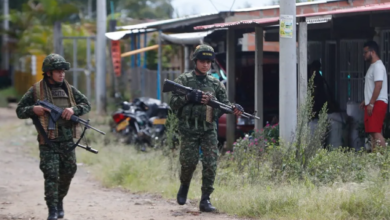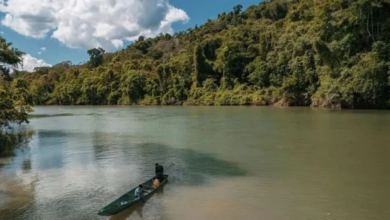Ecuador’s Golden Rush Brings Profit, Danger, And Haunting Violent Ties

A tragic ambush in Ecuador’s Amazon region has left eleven soldiers and one alleged insurgent dead, spotlighting the deadly nexus between illegal gold mining and organized crime. As insecurity rises, calls for urgent economic reforms and more vigorous enforcement grow louder.
A Deadly Clash in the Amazon
A recent conflict began in the Alto Punino area, which joins the Napo and Orellana provinces in northern Ecuador. Unlawful gold extraction locations have increased in number during the last few years. The camps draw people and crime organizations. Given rising gold costs, they want fast money.
What began as a routine operation against unlicensed miners quickly turned into a massacre when a team of 80 Ecuadorian soldiers touched down via helicopter to dismantle illicit mining activities. One four-member squad came under sudden, brutal attack with grenades, explosives, and assault rifles. Eleven soldiers were killed, with another wounded, and one member of the unidentified armed group also died.
Military officials blamed the assault on Comandos de la Frontera, a dissident group linked to the former FARC guerrillas of neighboring Colombia. However, soon after the ambush, a message attributed to the group emerged in Colombian media disclaiming responsibility and pointing toward Ecuadorian gangs such as Los Choneros, Los Lobos, or Los Tiguerones. The authenticity of this denial remains unverified, but Ecuadorian authorities have maintained their accusation against Comandos de la Frontera.
Ecuador’s president, Daniel Noboa, announced three days of national mourning because of the event. The dead soldiers are national heroes, according to him. He said the perpetrators would be found and ended. The country’s army shares his sentiment. To see the attackers and bring them to justice is what the army will do. Colombia’s defense minister also condemned the “brutal attack” and reiterated concerns about armed groups and their ties to transnational crime along the porous border region.
This is not the first such incident in Alto Punino. A similar armed confrontation in early 2022 left one Colombian national dead and two others captured. With the 2024 declaration of an “internal armed conflict” in Ecuador to confront spiraling crime, the line between combatting powerful cartels, dissident guerrilla factions, and local criminal gangs continues to blur.
The Lure of Illicit Riches
For many in Ecuador’s Amazon, illegal mining has become an enticing—if hazardous—source of income. Rising global gold prices have transformed remote jungle outposts into clandestine extraction camps where men, women, and sometimes entire families labor in harsh conditions, panning rivers and excavating soil with potential riches.
Yet the human and environmental toll is massive. According to a recent Andean Amazon Monitoring Project (MAAP) report, nearly 1,500 hectares of pristine rainforest in the Punino River basin have been destroyed by illegal mining since 2019. Makeshift camps often rely on mercury to separate gold from sediment, polluting waterways that sustain indigenous communities and regional biodiversity.
Gold’s unofficial economy has become connected to drug networks. Cocaine smuggling groups noticed a chance to spread revenue sources. They used their logistical knowledge and brutality. Groups with weapons require payments from miners for security or directly operate whole mines. They use violence to maintain control. In some cases, they even supply the heavy machinery—excavators, pumps, and motorized barges—essential for industrial-scale mining.
Beyond environmental devastation, the social costs are grave. Desperate workers, lured by promises of relatively quick cash, fall prey to exploitative working conditions, extortion, or even forced labor. Communities that once relied on fishing and small-scale agriculture now find their rivers contaminated, their forests scarred, and their sense of security shattered by roaming armed factions.
The profitability of illegal gold extraction is fueled by the ease of laundering gold on international markets. Gold undergoes a simple process of melting and selling compared to medications because it does not need difficult transport paths. Little documentation is sufficient for its sale. Tracing its source becomes nearly impossible after gold is within the global supply network. This situation led activists and governments to advocate stricter tracking rules. They also want solid approval procedures for precious metals.
A Regional Struggle for Solutions
In Ecuador, the massacre at Alto Punino causes discussion about addressing illegal mining. Organized crime and basic economic needs are also under review. Public officials are torn between aggressive crackdowns—such as sending military units into remote camps—and efforts to offer regulated livelihoods for communities that have come to depend on underground mining. President Noboa’s government frames the crisis as part of the broader war on organized crime, which has escalated homicide rates to among the highest in Latin America.
Enforcing the law in far-flung Amazonian regions is fraught with challenges. Infrastructure is sparse, and security forces struggle to maintain a lasting presence. Armed groups change often. They move to new locations when authorities attack common sites. Some people say military actions can force criminals further into the jungle. This can cause them to develop improved methods for avoiding capture.
Close-by nations also have problems. Peruvian authorities recently imposed a curfew and deployed troops in Pataz, where 13 employees of a small-scale mining operation were kidnapped and murdered. This mirrors a pattern unfolding throughout the Andes and Amazon: as one illicit income stream faces pressure, criminal networks pivot to another—whether that means drugs, extortion, or illegal resource extraction.
Indeed, environmental activists stress that a coordinated, transnational approach is vital. The porous borders between Ecuador, Colombia, and Peru enable armed groups to exploit law enforcement capabilities and governance differences. Some call for a regional pact that expands intelligence-sharing cuts off black-market supply chains and provides economic alternatives for impoverished communities. Others propose stricter international regulations for gold trading, similar to existing measures designed to stem “conflict minerals” in Africa.
While governments grapple with immediate security concerns, many observers emphasize the need for structural reforms in the economies of vulnerable areas. Funds for education, health care, and job programs that continue to operate are an avenue for hope and reduce people’s willingness to risk life in illegal mines. Official support for responsible and small-scale mining cooperatives can bring unregulated operators into legal setups, possibly limiting the effect of violent groups.
Yet the path forward remains riddled with obstacles. In Alto Punino, the families who lost loved ones—both soldiers and miners—still confront the harsh aftermath of this tragedy. A swirl of claims and counterclaims about who orchestrated the ambush muddies prospects for swift justice. At the same time, the Amazon rainforests, the location of incredible biodiversity and indigenous cultures, are continually threatened by gold exploitation.
Ecuador faces a choice. It must weigh the harmful appeal of unlawful gold against the need to defend its population, the land, and the country’s freedom. Whether the region can address the root causes of the crisis—poverty, criminal profiteering, and weak governance—will determine whether such violence continues or if a more sustainable future can emerge from the depths of the Amazon.
Also Read: Ecuador’s Blooming Roses Enchant Mother’s Day Buyers Globally
The tragedy at Alto Punino may serve as a stark warning. Gold continues to have worldwide appeal. Efforts to stop illegal mining must expand. The expansion should bring together law enforcement, policy changes, and chances for financial advancement. Amazon would continue to be profitable but dangerous without cooperative action. In this place, people die, and essential parts of the environment are lost for the possibility of finding hidden wealth.




